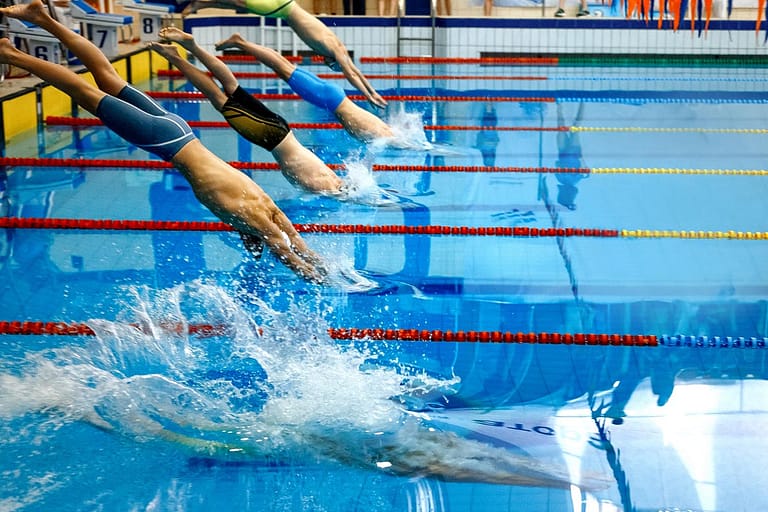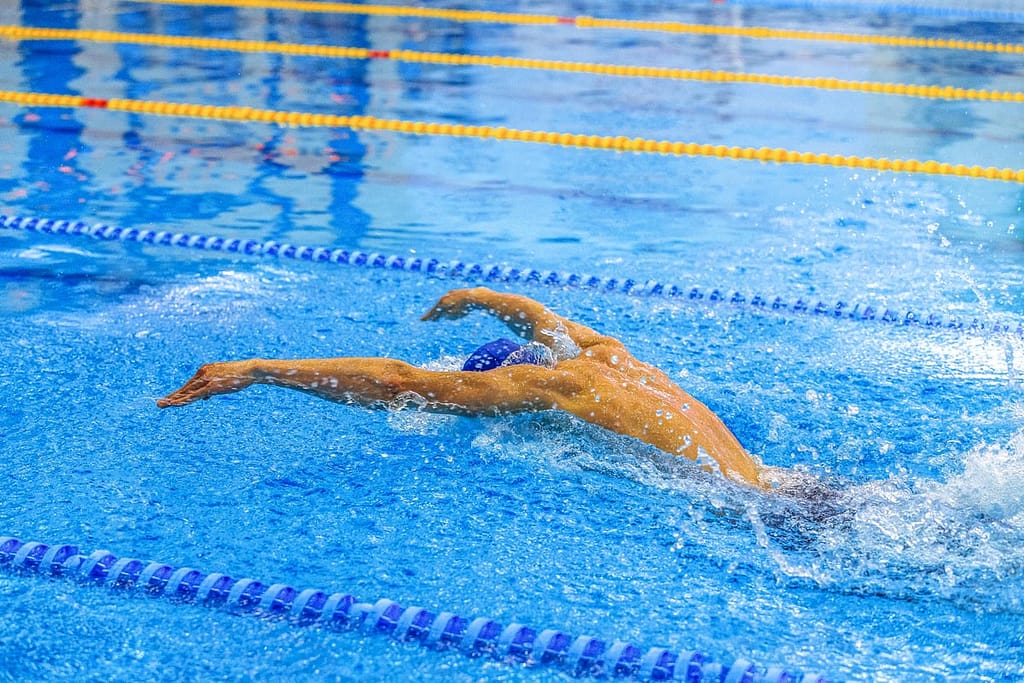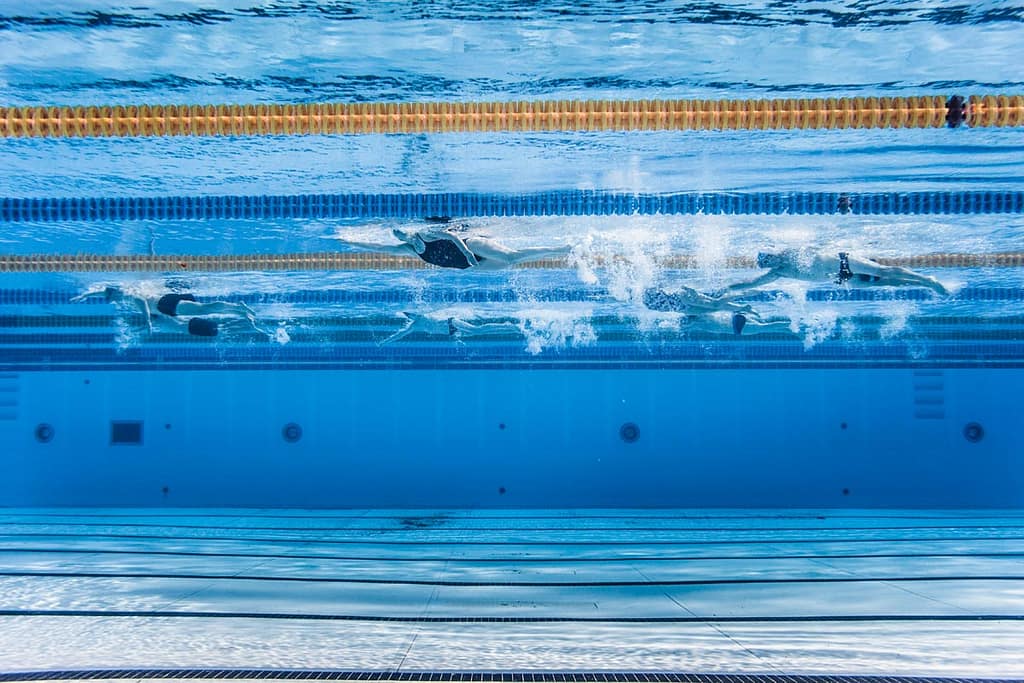What is Swimming? Glorious Past, Bright Future
What is swimming? A beloved activity that has been around for centuries. It’s a great way to stay fit, have fun, and even compete at the highest levels. Here’s a quick look at the history of swimming and why it’s still so popular today:
- Swimming has been around since ancient times
- It became an Olympic sport in 1896
- Today, millions of people swim for fitness and fun
- More people than ever are swimming competitively. Athletes break records often.

The Different Swimming Strokes: A Guide to Freestyle, Backstroke, Breaststroke, and Butterfly
There are four main swimming strokes that you’ll see in competitions and at the pool:
- Freestyle: Also known as the front crawl, this is the fastest and most popular stroke
- Backstroke: As the name suggests, you swim on your back using an alternating arm motion
- Breaststroke: A slower stroke that involves a simultaneous arm and leg movement
- Butterfly: The most difficult stroke, featuring a dolphin-like kick and simultaneous arm movement
There are also individual medley events. Swimmers use all four strokes. There are also relays. Teams of swimmers compete together.
Swimming Techniques: Tips and Tricks to Improve Your Performance in the Water
Whether you’re a beginner or an experienced swimmer. There’s always room to improve your technique. Here are some tips:
- Focus on your body position and alignment in the water
- Work on your kick and make sure it’s propelling you forward
- Practice your breathing technique and find a rhythm that works for you
- Use swim drills to isolate specific parts of your stroke and perfect them
You can also try swim workouts with sets and intervals to build endurance and speed. Also, don’t forget about dryland training. It builds strength and flexibility outside the pool.
Swimwear Essentials: What to Wear When Swimming and Why It Matters
Having the right gear can make a big difference in your swimming experience. Here are some essentials:
- Swim caps to protect your hair and reduce drag
- Goggles to see underwater and protect your eyes
- Swimsuits that fit well. They are designed for your specific needs (e.g. training, competition)
- Tech suits for competitions that can help reduce drag and improve performance
You might also want to invest in fins, paddles, pull buoys, and kickboards for training.
Pool vs. Open Water Swimming: Which is Right for You?
Swimming isn’t just limited to pools. Open water swimming in lakes, rivers, and oceans is becoming increasingly popular. Here are some key differences:
| Pool Swimming | Open Water Swimming |
|---|---|
| Controlled environment | Unpredictable conditions |
| Clear water | Murky or dark water |
| Lane lines and walls | No boundaries or guidance |
| Consistent temperature | Variable temperatures |
Open water swimming requires different skills and equipment, such as navigation and wetsuits. But it can be a fun and challenging way to mix up your swimming routine.

Health Benefits of Swimming: How Swimming Can Improve Your Fitness and Well-being
Swimming isn’t just fun – it’s also really good for you. Here are some of the health benefits:
- Full-body workout that engages all your muscles
- Low-impact exercise that’s easy on your joints
- Improves cardiovascular health and lung capacity
- Burns calories and can help with weight management
- Reduces stress and improves mental well-being
Swimming is a great activity for people of all ages and fitness levels. And with so many different ways to swim, you’re sure to find a style that works for you.
Swimming as a Competitive Sport: The Road to Becoming an Olympic Swimmer
For some people, swimming is more than just a hobby – it’s a serious competitive sport. Here’s what it takes to become an Olympic swimmer:
- Start young and join a swim club or team
- Train hard and consistently, with a focus on technique and endurance
- Compete at swim meets and work your way up to national championships
- Qualify for international competitions like the World Championships and Olympics
- Train at the highest level with top coaches and facilities
It’s a long and challenging road, but for those who make it, the rewards are incredible. Just ask swimmers like Michael Phelps and Katie Ledecky. They have won dozens of Olympic medals.
Swimming for Beginners: Getting Started in the Pool and Overcoming Common Challenges
If you’re new to swimming, it can be intimidating to get started. But don’t worry – everyone has to start somewhere. Here are some tips for beginners:
- Start with swim lessons to learn proper technique and safety skills
- Practice in shallow water until you feel comfortable going deeper
- Use flotation devices like kickboards and pull buoys to help with technique
- Take breaks as needed and don’t push yourself too hard too fast
- Join a swim club or masters swimming group for support and motivation
Beginners face common challenges. These include fear of the water, trouble with breathing, and fatigue. But with practice and persistence, you can clear these hurdles. Then, you can become a confident swimmer.

Swimming and Safety: Important Tips for Staying Safe in the Water
While swimming is a fun and healthy activity, it’s important to prioritize safety. Here are some key tips:
- Never swim alone – always have a buddy or lifeguard present
- Know your limits and don’t push yourself too hard
- Be aware of water conditions and hazards like currents and waves
- Wear appropriate safety gear like life jackets when necessary
- Learn basic rescue skills like CPR and first aid
Follow these guidelines. Then, you can swim safely and enjoyably.
Swimming and Mental Health: Swimming can Reduce Stress and Improve Mental Well-Being.
Swimming has physical benefits. It can also help mental health. Here’s how:
- Provides a sense of calm and relaxation
- Releases endorphins that boost mood and reduce stress
- Offers a meditative and mindful experience
- Provides a sense of accomplishment and self-esteem
- Connects you with a supportive community of fellow swimmers
Many people find that swimming helps them manage stress, anxiety, and depression. And with the added benefits of physical fitness, it’s a powerful tool for overall well-being.
Famous Swimmers and Their Inspiring Stories: From Michael Phelps to Katie Ledecky
Throughout history, many amazing swimmers have inspired others. They did so with their achievements and stories. Here are just a few examples:
- Michael Phelps, the most decorated Olympian of all time with 28 medals
- Katie Ledecky, a dominant force in women’s swimming with multiple world records
- Mark Spitz, who won seven gold medals in the 1972 Olympics
- Dara Torres, who competed in five Olympic Games spanning three decades
- Natalie du Toit is a South African swimmer. She competed in both the Olympics and Paralympics.
These swimmers, and many others, have shown us what’s possible. It happens when you dedicate yourself to a sport and a dream. They’ve overcome obstacles, broken barriers, and inspired generations of swimmers to come.

